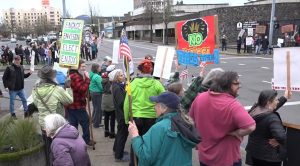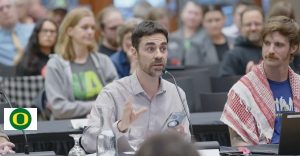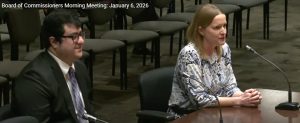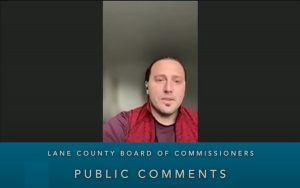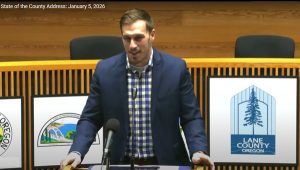City chooses ‘enhanced corridor’ for River Road, looks for quick safety improvements
10 min read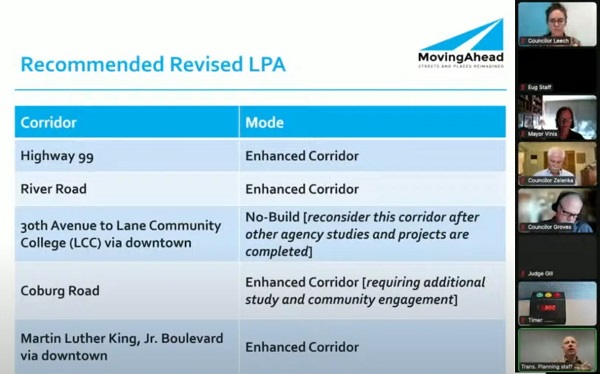
The Eugene City Council follows Lane Transit District in dropping plans for EmX bus rapid transit on River Road. The city is still committed to improving safety on the corridor, according to Transportation Planning Manager Rob Inerfeld.
Rob Inerfeld (Eugene transportation planning): The city of Eugene and Lane Transit District are collaborating on the MovingAhead project to redesign major streets in Eugene to make them work better for taking the bus, walking and biking.
Since the locally preferred alternative EmX on River Road was adopted in March 2022, LTD staff have spent time thinking about how to provide frequent transit service at lower costs. LTD spent a year analyzing this option and ultimately determined that the enhanced corridor had a much better benefit-to-cost ratio for the community.
[00:00:55] This led to a recommendation to change River Road from ‘EmX’ to ‘Enhanced Corridor’ in terms of the locally preferred alternative. And this was approved by the LTD Board on May 15 of this year. This work session tonight is an opportunity for the City Council to change the city of Eugene’s designation of locally preferred alternative for River Road to match the action taken by the LTD board.
[00:01:26] Unlike the EmX alternative, the enhanced corridor option can be implemented incrementally. Since the enhanced corridor uses regular buses, it can be implemented over time with smaller grants that are more achievable for our community. In 2018 before we had a rapid rise in construction costs, the EmX alternative was estimated to cost $78 million while the enhanced corridor had a cost of $24 million.
The city staff are still focused on making this a safe corridor for everyone, including people walking, biking, rolling, taking the bus, and driving. River Road is one of the city’s high-crash corridors and we continue to apply for grant opportunities to make it safer.
[00:02:17] We also plan to continue to engage with the community on how to make River Road work better, both both city staff and Lane Transit District staff. And in fact, we were just invited to a special River Road Community Organization meeting focused on transportation that’s taking place on Monday, July 1.
[00:02:36] Councilor Mike Clark: I’m wondering if you would like to characterize some of the pieces of what an enhanced corridor looks like. In other words, have you studied already the number of trees that come down, the impacts in properties along River Road, which number of properties would be affected? Could you maybe give us out loud some idea of that?
[00:03:01] Rob Inerfeld (Eugene transportation planning): As a comparison, the number of medium and large trees impacted for enhanced is 13; for EmX, it’s 132. The number of acquisitions for enhanced is five properties, and for EmX, it would be 40; and acreage-wise, it’s 1.3 acres compared to 2.2. And I believe those are, like, a lot of those are small acquisitions, so that’s not displacements. It might be a strip of property. I think for a lot of the EmX stations, it would have been small strips of property.
[00:03:33] There’s four potential property displacements for enhanced (corridor) and six for EmX. I’m pretty sure those are all near the Beltline interchange, where, again, that’s really the biggest choke point for buses on River Road. Does that answer your question?
[00:03:50] Councilor Mike Clark: It does. I think that gives a good comparison to folks who may be listening of understanding of the impact for our voting in favor of this. I have some concerns with it. I continue to have objection to the idea of enhanced corridor for Coburg Road as well…
[00:04:06] I guess I’ll just say as an explanatory note, I will vote ‘No’ on this. Another reason for my no vote was a lack of complete detail. Rob, I appreciated your synopsis of what will happen within an enhanced corridor, but there are an awful lot of people with an awful lot of concerns, and I don’t want to advance this until I know more about what would be the impacts.
[00:04:28] Councilor Randy Groves: First of all, I want to say I really support us pulling EmX out of the plan and replacing it with enhanced corridor, although I too would like to have a better understanding of exactly what all that entails. You helped quite a bit there, Rob, just explaining the difference in land acquisition, but I’m still concerned about really any land acquisition, especially if it has to go through condemnation. When you’re saying this gives us an opportunity to incrementally develop, what is that incrementally towards?
[00:05:05] Rob Inerfeld (Eugene transportation planning): LTD’s long-range transit plan, and I believe the transportation system plan as well, call for frequent transit corridors, so, where buses would be running more frequently. In fact, they’re going through a process right now at LTD called the ‘system review,’ where they’re trying to have 15-minute service on more of their corridors, because that’s shown to work much better, both for existing transit riders, but also to attract additional people to transit in a similar way that the EmX does.
[00:05:31] So, in order to have frequent service, the buses have to be able to efficiently travel on the street. If there’s places along the corridor where buses are stuck in traffic, there’s a need for some small intervention that that could be done one at a time, because we’re just talking about regular buses running on city streets.
[00:05:48] So there’s some examples around Eugene where there’s regular bus routes that have what are called ‘queue jumps.’ There’s one by the Hilyard Community Center where the buses have their own lane just for a short section and then they have their own signal. There’s also one in Coburg Road going northbound just south of Martin Luther King Jr. Boulevard.
[00:06:05] So there’s these small interventions that can be done to help buses get more smoothly through traffic. It could also mean enhanced passenger facilities, nicer bus shelters, in some cases, it could mean better sidewalk connections to the buses.
[00:06:19] One thing that’s really important is the pedestrian crossings. If you just think about somebody taking a bus from their home to where they’re going, and then back again, they’re going to have to cross River Road at some point in their trip, either on the way out or the way back. And so that crossing needs to be safe and comfortable for that person.
[00:06:36] If we were to move forward with an enhanced corridor, one of the things we would probably look at prioritizing is how to make sure there’s enhanced crossings, especially at the busiest bus stops along River Road. And those don’t require any additional right of way.
[00:06:50] Councilor Randy Groves: Okay, I appreciate that. That helps a lot. I’m all for whatever we can do to improve safety for pedestrian and bicyclists as well. I just want to make sure this isn’t all of a sudden we’re starting to build towards EmX for the future. That’s a discussion that we really need to have before we get back on that train again.
[00:07:13] Councilor Alan Zelenka: Yeah, you know, I think EmX has been a tremendous success in numerous ways. I would actually like to see it expand and I think in 20 years we’ll wish we had, especially in some parts of the city. The initial EmX project was mostly paid for by feds and the state.
[00:07:33] Benefit of going first and being innovative is pilot projects get paid for. So fortunately, EmX was, I think, the right project at the right time, but I think times have changed. I think we’ve got a 50% match requirement now. We’ve got increased construction costs. We’ve got a decrease in ridership ’cause of the pandemic and other factors.
[00:07:56] That means we’re not going to be able to expand EmX, which is kind of sad and regrettable. But I support matching with LTD’s board decision and moving forward. While we’re not going to get EmX, we’ll still get enhancement of bike and ped modes and hopefully make the corridor a lot safer for both bikes and pedestrians as we move through and enhancing that River Road corridor but the rest of the corridors as well.
[00:08:29] So the benefit that we have now isn’t EmX. The benefit we have now is more on bike and pedestrian safety and getting us more towards our Vision Zero goals.
[00:08:43] Councilor Lyndsie Leech: You know, I live on River Road and talking to my neighbors and my constituents, and it’s very apparent to me that the road is treated like a highway, people use it like a highway. It’s very unsafe for people to walk and bike. And those are my top concerns.
[00:08:59] And, you know, I’ve reviewed the last, you know, many, many years of public surveys that some of the community organizations have done and walking and biking safety and on this high, very high crash corridor has been designated as some of the top priorities across the entire community in the River Road area.
[00:09:19] So I think focusing on those safe pedestrian crossings, making them enhanced right now the way they are—I mean, I worry every day because people are going so fast that their ability to stop at the little yellow flashing lights is actually pretty limited. I see crashes all the time. That Beltline congestion is actually very problematic. And so I’m really looking forward to this enhanced corridor project. I support it.
[00:09:47] I’m glad that we’re going to be able to move forward and start doing this construction as soon as possible and in that safety and pedestrian safety way. And I hope that will also help with some traffic calming and getting us into more of that Vision Zero.
[00:10:08] Councilor Greg Evans: Rob, you talked about the enhancements to deal with the choke points at Beltline, including queue jumping. So you get signal priority for the buses coming through those intersections, but my main question is that the (Route) 51 is probably the second-most-used line in terms of ridership in the system behind the number (Route) 11, and one of the problems that has been consistent with getting the 51 through the corridor and on time into Eugene Station is that there is a choke point at the 1st Street crossing with the railroad and with the Amtrak traffic and all the rest of that. Is there any plan to address that specific choke point?
[00:11:03] Rob Inerfeld (Eugene transportation planning): LTD is currently going through a process called a system review. They’re making a bunch of recommendations. They have a consulting firm called Nelson\Nygaard that’s working with them closely and that has just made a bunch of recommendations around how to make changes to the operations service.
[00:11:20] But I’m just not sure what is proposed for 51. I’m not sure if it would avoid the railroad tracks or not. I can get back to you as to whether they’re proposing to make a change to that. I know at least one of the routes that proposed me to make it so it doesn’t go over the tracks.
[00:11:35] John Q: The change won’t mean smaller buses
[00:11:39] Councilor Greg Evans: I don’t want people to get the wrong impression of a regular bus versus an EmX coach. An EmX coach is a 60-foot articulated bus with a different paint job and some different amenities to it, but we still have 60-foot buses running through that corridor…We are running 60-foot buses on the 51 line right now. We’ve been doing it for years. I don’t want people to get the idea that all of a sudden the articulated buses are not going to be there or could disappear in favor of a 40-foot bus.
[00:12:18] Councilor Matt Keating: I have a question about the enhanced corridor. Does increasing the number of enhanced corridors, or increasing the investments, does that do so at the expense of decreasing transit opportunities within our communities?
[00:12:36] Rob Inerfeld (Eugene transportation planning): Are you suggesting like it could mean more service in one corridor at the expense of another bus route? (That’s what I’m asking, yeah.) Right. I don’t think so. I think LTD’s, these are major corridors that where they have a long-term goal of having more frequent service. It’s embedded in their policies and in their plans and so 15-minute service on these corridors is kind of where they’re moving already. So I do not think this is at the expense of like local bus service and, you know, service to routes in some of the neighborhoods.
[00:13:07] Mayor Lucy Vinis: I also did want to support this alignment of the city’s language with LTD’s vote and really recognize that the significance here is that we really want a safer corridor, that this is basically a highway that runs through a neighborhood and cars go too fast and it’s too hard for people to bike and to walk and buses get caught in traffic.
[00:13:27] The larger principle here is to enable people to move safely through and across that corridor and right-size our solution to what the current circumstances are, so it makes enormous amount of sense given the rising costs and the transition that LTD is facing in terms of ridership and how to be responsive and get more people on the bus.
[00:13:47] John Q: The city looks to reduce fatalities and severe injuries on River Road, and joins LTD in looking for incremental changes to enhance safety and improve bus service along one of Eugene’s major corridors.
